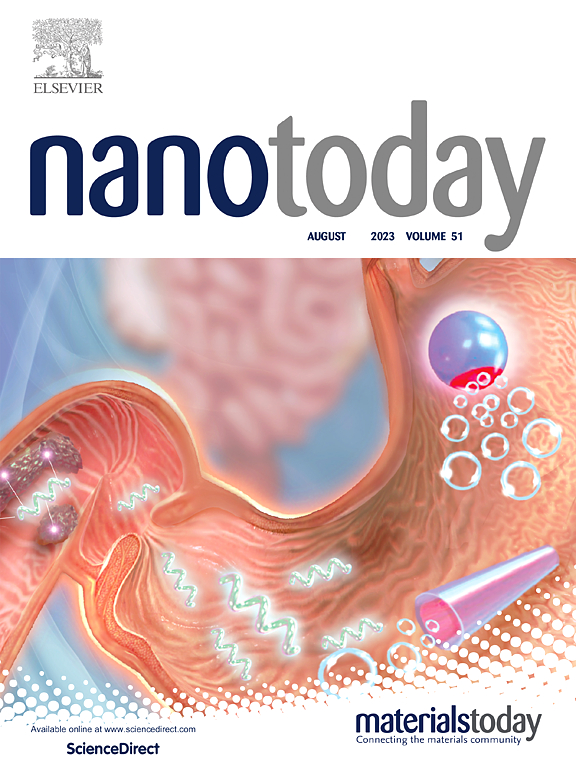增强压电的纳米限制异质结放大活性氧风暴引发的肿瘤铁致凋亡样/凋亡
IF 10.9
1区 材料科学
Q1 CHEMISTRY, MULTIDISCIPLINARY
引用次数: 0
摘要
电子-空穴对分离差、重组快,影响了超声增敏剂的活性氧(ROS)生成效率,影响了肿瘤治疗效果。为了克服这些障碍,我们提出了纳米约束增强策略来构建负载IrO2的聚乙烯吡咯烷酮修饰zno纳米药物(IZH)用于压电治疗。纳米约束激活IrO2纳米团簇进行载流子分离,超声辐照下IZH(29.4 nA cm−2)的超声电流密度是ZnO2(10.3 nA cm−2)的2.9倍。此外,在超声波作用下,IrO2和ZnO2之间的内部电场加速了电子定向迁移。有趣的是,这种策略增强了ROS的产生,诱导了铁中毒样/细胞凋亡,肿瘤抑制率为90% %。该研究提供了一个有前景的纳米平台,通过基于铱的纳米约束压电声敏剂对铁中毒样和细胞凋亡进行有效的载流子分离,从而增强ROS的产生,为探索压电疗法的候选药物提供了新的指导。本文章由计算机程序翻译,如有差异,请以英文原文为准。
Nanoconfined heterojunctions with enhanced piezoelectricity for amplifying reactive oxygen species storms-triggered tumor ferroptosis-like/apoptosis
Poor separation and rapid recombination of electron-hole pairs hinder the reactive oxygen species (ROS) generation efficiency of sonosensitizers and hampers the efficacy of tumor therapy. To overcome these obstacles, the nanoconfinement-enhanced strategy was proposed to construct polyvinylpyrrolidone-modified ZnO2 nanomedicines loaded with IrO2 (IZH) for piezoelectric therapy. Nanoconfinement activates IrO2 nanoclusters for carrier separation, and the ultrasound current density of IZH (29.4 nA cm−2) is 2.9 times that of ZnO2 (10.3 nA cm−2) under the ultrasound irradiation. In addition, the internal electric field between IrO2 and ZnO2 accelerates electron directed migration under ultrasound. Interestingly, this strategy augmented ROS generation induces ferroptosis-like/apoptosis with the tumor inhibition rate of 90 %. This study provides an promising nanoplatform to trigger efficient carrier separation for enhancing ROS generation through an iridium-based nanoconfinement piezoelectric sonosensitizer on ferroptosis-like and apoptosis, providing new guidance for exploring candidates for piezoelectric therapy.
求助全文
通过发布文献求助,成功后即可免费获取论文全文。
去求助
来源期刊

Nano Today
工程技术-材料科学:综合
CiteScore
21.50
自引率
3.40%
发文量
305
审稿时长
40 days
期刊介绍:
Nano Today is a journal dedicated to publishing influential and innovative work in the field of nanoscience and technology. It covers a wide range of subject areas including biomaterials, materials chemistry, materials science, chemistry, bioengineering, biochemistry, genetics and molecular biology, engineering, and nanotechnology. The journal considers articles that inform readers about the latest research, breakthroughs, and topical issues in these fields. It provides comprehensive coverage through a mixture of peer-reviewed articles, research news, and information on key developments. Nano Today is abstracted and indexed in Science Citation Index, Ei Compendex, Embase, Scopus, and INSPEC.
 求助内容:
求助内容: 应助结果提醒方式:
应助结果提醒方式:


